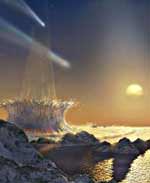In the last few decades, scientists have discovered that there is a lot more to the universe than meets the eye: The cosmos appears to be filled with not just one, but two invisible constituents-dark matter and dark energy-whose existence has been proposed based solely on their gravitational effects on ordinary matter and energy.
Now, theoretical physicist Robert J. Scherrer has come up with a model that could cut the mystery in half by explaining dark matter and dark energy as two aspects of a single unknown force. His model is described in a paper titled “Purely Kinetic k Essence as Unified Dark Matter” published online by Physical Review Letters on June 30 and available online at http://arxiv.org/abs/astro-ph/0402316.
“One way to think of this is that the universe is filled with an invisible fluid that exerts pressure on ordinary matter and changes the way that the universe expands,” says Scherrer, a professor of physics at Vanderbilt University.
According to Scherrer, his model is extremely simple and avoids the major problems that have characterized previous efforts to unify dark matter and dark energy.
In the 1970s, astrophysicists postulated the existence of invisible particles called dark matter in order to explain the motion of galaxies. Based on these observations, they estimate that there must be about 10 times as much dark matter in the universe as ordinary matter. One possible explanation for dark matter is that it is made up of a new type of particle (dubbed Weakly Interacting Massive Particles, or WIMPs) that don’t emit light and barely interact with ordinary matter. A number of experiments are searching for evidence of these particles.
As if that weren’t enough, in the 1990s along came dark energy, which produces a repulsive force that appears to be ripping the universe apart. Scientists invoked dark energy to explain the surprise discovery that the rate at which the universe is expanding is not slowing, as most cosmologists had thought, but is accelerating instead. According to the latest estimates, dark energy makes up 75 percent of the universe and dark matter accounts for another 23 percent, leaving ordinary matter and energy with a distinctly minority role of only 2 percent.
Scherrer’s unifying idea is an exotic form of energy with well-defined but complicated properties called a scalar field. In this context, a field is a physical quantity possessing energy and pressure that is spread throughout space. Cosmologists first invoked scalar fields to explain cosmic inflation, a period shortly after the Big Bang when the universe appears to have undergone an episode of hyper-expansion, inflating billions upon billions of times in less than a second.
Specifically, Scherrer uses a second-generation scalar field, known as a k-essence, in his model. K-essence fields have been advanced by Paul Steinhardt at Princeton University and others as an explanation for dark energy, but Scherrer is the first to point out that one simple type of k-essence field can also produce the effects attributed to dark matter.
Scientists differentiate between dark matter and dark energy because they seem to behave differently. Dark matter appears to have mass and to form giant clumps. In fact, cosmologists calculate that the gravitational attraction of these clumps played a key role in causing ordinary matter to form galaxies. Dark energy, by contrast, appears to be without mass and spreads uniformly throughout space where it acts as a kind of anti-gravity, a repulsive force that is pushing the universe apart.
K-essence fields can change their behavior over time. When investigating a very simple type of k-essence field-one in which potential energy is a constant-Scherrer discovered that as the field evolves, it passes through a phase where it can clump and mimic the effect of invisible particles followed by a phase when it spreads uniformly throughout space and takes on the characteristics of dark energy.
“The model naturally evolves into a state where it looks like dark matter for a while and then it looks like dark energy,” Scherrer says. “When I realized this, I thought, ‘This is compelling, let’s see what we can do with it.'”
When he examined the model in more detail, Scherrer found that it avoids many of the problems that have plagued previous theories that attempt to unify dark matter and dark energy.
The earliest model for dark energy was made by modifying the general theory of relativity to include a term called the cosmological constant. This was a term that Einstein originally included to balance the force of gravity in order to form a static universe. But he cheerfully dropped the constant when astronomical observations of the day found it was not needed. Recent models reintroducing the cosmological constant do a good job of reproducing the effects of dark energy but do not explain dark matter.
One attempt to unify dark matter and dark energy, called the Chaplygin gas model, is based on work by a Russian physicist in the 1930s. It produces an initial dark matter-like stage followed by a dark energy-like evolution, but it has trouble explaining the process of galaxy formation.
Scherrer’s formulation has some similarities to a unified theory proposed earlier this year by Nima Arkani-Hamed at Harvard University and his colleagues, who attempt to explain dark matter and dark energy as arising from the behavior of an invisible and omnipresent fluid that they call a “ghost condensate.”
Although Scherrer’s model has a number of positive features, it also has some drawbacks. For one thing, it requires some extreme “fine-tuning” to work. The physicist also cautions that more study will be required to determine if the model’s behavior is consistent with other observations. In addition, it cannot answer the coincidence problem: Why we live at the only time in the history of the universe when the densities calculated for dark matter and dark energy are comparable. Scientists are suspicious of this because it suggests that there is something special about the present era.
Original Source: Vanderbilt University News Release

